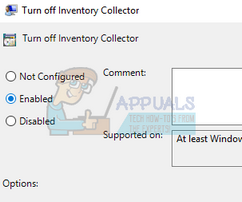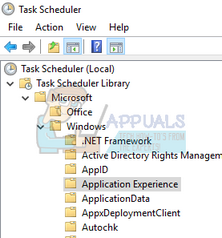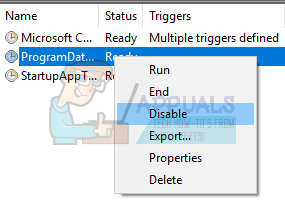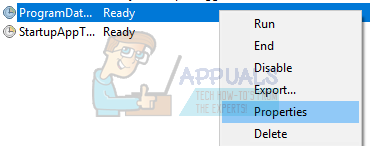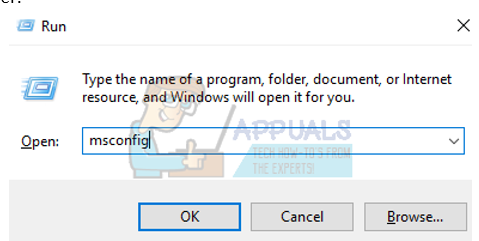There is no way to directly launch a DLL file. The rundll32.exe is simply used to launch the functionality stored in shared .dll files. Do note that sometimes some malware infect machines by creating an alias of rundll32. You should scan your computer and check for any discrepancies.
Solution 1: Disabling items from Task Scheduler
If you are experiencing problems right after installing a Windows 10, it is possible that some Windows processes are causing the rundll32.exe to consume so much CPU and Disk usage. This was the case for the majority of the users but if it doesn’t work for you, you can always revert back the changes anytime using the same method.
Task Scheduler Library > Microsoft > Windows > Customer Experience Improvement
Consolidator KernelCeip Task UsbCeip
Solution 2: Disabling Telemetry Services
Part of Microsoft’s user experience program is to gather data from your system and compare it to PC’s. This will then locate any discrepancies/changes which will be used to improve the user experience in the future. This feature is also known to cause several high disk/CPU usage problems. We can try disabling it and check if the problem still persists.
Solution 3: Renaming aienv.dll
aienv.dll is a library file of the Application Experience Inventory in Windows. It is a non-system process and originates from software/application installed on your computer. Many users reported that stopping the service or renaming it caused their issue of disk/CPU usage to get fixed. We can try the same. Follow this method at your own risk, it is advised that you create a Windows restore point in case anything goes wrong. C:\Windows\System32 You can also copy the above address, press Windows + R, paste the address and press Enter to navigate to the location directly.
Solution 4: Uninstalling Google App Engine
Google App Engine is a web framework for developing/hosting web applications in Google-managed data centers. This application offers automatic scaling for web applications as the number of requests for the application increases. It has multiple supported languages such as Java, Ruby, Python and other JVM languages. Many users reported that after the installation of Google App Engine, their disk/CPU usage increased dramatically through the process of rundll32.exe. You can try uninstalling the application and check if the problem still persists.
Solution 5: Checking through Process Explorer
Process Explorer is a tool by Microsoft which shows you information regarding which DLL’s have been opened/loaded along with all the details about which parent process started it. It gives you information regarding the resources consumed, CPU usage etc. We can try checking for processes using rundll32.exe and troubleshoot why they are using it.
Solution 6: Uninstalling Lenovo Dependency Package
If you are running a Lenovo, you must check if the uninstallation of Lenovo Dependency Package solves your problem. It is a set of services/drivers installed on a Lenovo machine to help the Metro application “Lenovo Settings”. By itself, the dependency package doesn’t do anything. As a precaution, create a restore point for your Windows before performing this solution.
Solution 7: Disabling Inventory Collector
Inventory Collector is a tool by Microsoft which helps you examine your organization’s computers, identify the installed applications, devices, and system information, in order to collect a catalog of information. You can view this data using the Application Compatibility Manager. If you don’t use this feature, we can try disabling it and check if it brings any luck to our problem. Computer Configuration > Administrative Templates > Windows Components > Application Compatibility
Solution 8: Amending ProgramDataUpdater
Many users reported that the task “ProgramDataUpdater” belonging to the category of Application Experience by Microsoft was causing high CPU/Disk usage on their computer. We have two options: either we can disable the task permanently or we can change the settings so the task gets automatically killed if it processes for more than a minute. We will guide you on how to disable the task completely first.
Microsoft > Windows > Application Experience
Now we cover on how to set a time limit as discussed above. You can either set the limit or disable the task permanently as mentioned above.
Solution 9: Booting in Safe Mode
By using the safe mode, we can determine whether the problem is due to any applications or the problem lies in the operating system. If the machine works perfectly in safe mode and the disk/CPU usage is normal, it means that some external application or service is causing the problem as all of these is disabled in safe mode. If there were no problems detected in the Safe mode, then you should perform a clean boot and determine which application/service is causing you the problem. If the problem still occurs in safe mode, it means the problem is with the operating system.This boot allows your PC to turn on with a minimal set of drivers and programs. Only the essential ones are enabled while all the other services are disabled.
Solution 10: Restoring Windows from Restore Point (Only if the problem doesn’t get fixed in Safe Mode)
If the problem still persists in Safe Mode (Solution 9), we can try restoring your Windows to a previous restore point you created. Save all your work correctly and backup any important data. Do note that all the changes to your system configurations after the last restore point will be removed.
You can learn more about system restore to gain more knowledge about what it does and what are the processes involved.
Fix: Windows Host process RunDLL32 has stopped workingWhat is ‘Modern Setup Host’ and How to Fix High Disk Usage by Modern Setup Host?Fix: High Disk or CPU Usage “Service Host Delivery Optimization"Fix: Host Process for Setting Synchronization (SettingSyncHost.exe) High CPU…
















